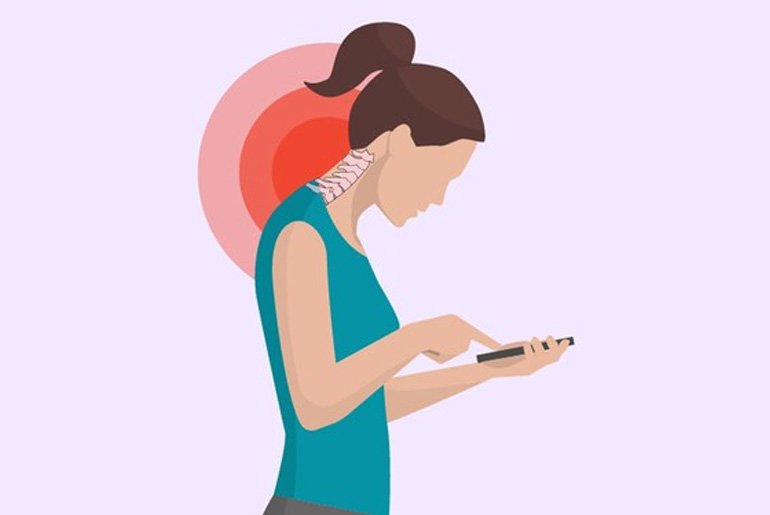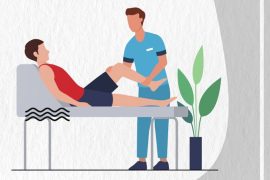In our digitalized world, where many of us use our phones throughout the day, maintaining a poor neck posture can have significant consequences. Specifically, a forward head posture, where the head protrudes forward from the shoulders, can place undue stress on the neck. This posture is often associated with activities such as prolonged periods of looking down at smartphones or computers. The impact of a forward head posture includes various health issues, ranging from neck pain and headaches to shoulder pain, reduced spinal flexibility, and potential long-term spinal problems.
The misalignment of the head with the spine during activities like prolonged smartphone or computer use can lead to discomfort and pain. Neck pain is a common outcome, and headaches may also result from the strain placed on the neck and upper spine. Shoulder pain can accompany these issues, as the forward head posture alters the natural alignment of the upper body. Additionally, maintaining this posture for extended periods may contribute to reduced spinal flexibility, impacting overall mobility and comfort.
It is crucial to be mindful of our neck posture, especially during activities that involve looking down at screens for extended durations. Taking breaks, adjusting screen heights, and incorporating neck exercises and stretches into our routine can help alleviate the stress on the neck and mitigate the potential long-term effects of poor posture. Developing healthy habits in our digital usage can contribute to better overall spinal health and well-being.
key points for achieving proper sitting posture:
- Align Your Head and Spine: Keep your head in a neutral position directly above your spine. Avoid leaning too far forward or backward.
- Sit Back in Your Chair: Utilize the backrest of your chair for support, and sit back to maintain the natural curve of your spine. This helps distribute weight evenly and reduces stress on the neck and lower back.
- Keep Feet Flat on the Floor: Ensure your feet are planted flat on the ground to provide support for your lower back. Use a footrest if necessary to maintain a comfortable position.
- Use an Ergonomic Chair: Opt for a chair that supports the natural curves of your spine and provides proper lumbar support. An ergonomic chair can promote a healthier sitting posture.
- Elevate Your Screen: Position your computer monitor or device at eye level to prevent excessive tilting of the head. This helps maintain a neutral neck position and avoids straining the muscles.
- Take Breaks: Stand up, stretch, and move around regularly. Taking breaks allows your muscles to relax, prevents stiffness, and improves circulation. Incorporate simple stretches and movements into your routine to counteract the effects of prolonged sitting.
These guidelines contribute to a more ergonomic and comfortable workspace, reducing the risk of neck pain, headaches, and other issues associated with poor posture.
A few yoga poses that may help:
Sukhasana (Easy Pose):
- Sit with your legs crossed, placing each foot under the opposite knee.
- Keep your spine straight and shoulders relaxed.
- Hold your phone at eye level to avoid tilting your head forward.
- This posture encourages an upright spine and reduces strain on the neck.
Tadasana (Mountain Pose):
- Stand with your feet together.
- Engage your thigh muscles and lift your chest while relaxing your shoulders down.
- Keep your head in a neutral position, aligning it with your spine.
- Tadasana promotes a straight, aligned posture, helping to balance and reduce strain on the neck.
Gomukhasana (Cow Face Pose):
- Sit comfortably with your legs crossed.
- Raise your right arm, bend the elbow, and bring your hand down your back.
- Lift your left arm, bend the elbow, and reach behind to clasp your fingers.
- This stretch opens the chest and shoulders, reducing strain on the neck caused by phone use.
Remember to practice these yoga poses mindfully, paying attention to your body’s cues, and adjusting as needed. If you are new to yoga or have specific concerns, consider consulting with a qualified yoga instructor for guidance tailored to your individual needs. Additionally, taking short breaks and incorporating neck stretches throughout the day can further help alleviate any discomfort associated with prolonged phone use or sitting.
Disclaimer:
The information contained in this article is for educational and informational purposes only and is not intended as a health advice. We would ask you to consult a qualified professional or medical expert to gain additional knowledge before you choose to consume any product or perform any exercise.







